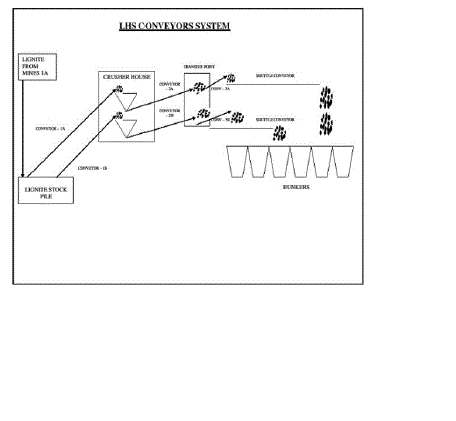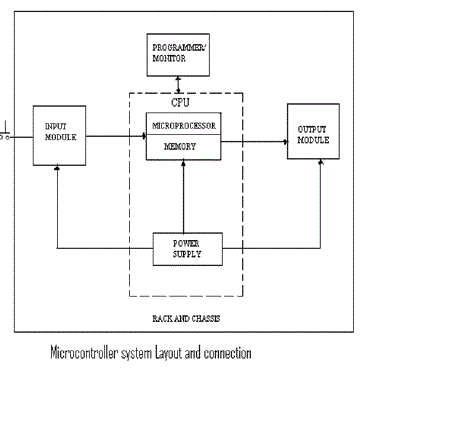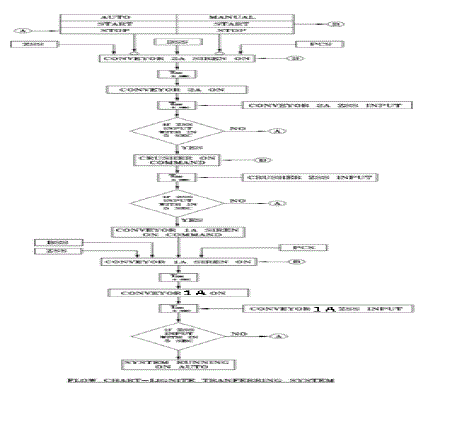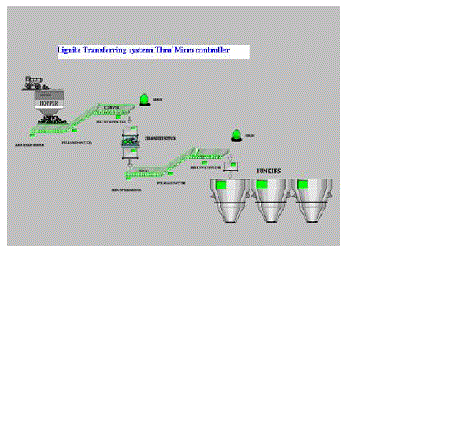ISSN ONLINE(2278-8875) PRINT (2320-3765)
ISSN ONLINE(2278-8875) PRINT (2320-3765)
| Mrs.M.Bharathi* M.Sowmiya** , C.Keerthika**, Aysha.G.V** |
| Related article at Pubmed, Scholar Google |
Visit for more related articles at International Journal of Advanced Research in Electrical, Electronics and Instrumentation Engineering
-This paper entitled “Lignite Handling System through MICROCONTROLLER” is performed to establish the remote operation of conveyors in the Fuel HandlingSystem for transferring the lignite from lignite stockpile to bunkers for every shift.The usual practice for this purpose is to use a number of relays which makes the circuit very complex. So MicroLogix1500 controller is used to reduce the circuit complexity, problems related with conventional relay logic system. We can overcome the manual operation by fully Automation, microcontroller is used to operate the machine in individual drive operation mode and Automatic operation mode. Using Indications, Interlocks and Alarm, made the system as a user friendly model.
INTRODUCTION |
| The ST-CMS 250MW Plant is the first biggest Lignite fired plant as a single unit of Independent Power producer category in India. It is located at Uthangal, 40KM west of Cuddalore, 12KM from Neyveli Township to the west of NLC TPS-II (Thermal Power Station-II) and to the north of Railway Line to Vridhachalam. The plant is designed to operate continuously at 104% TMCR (overpressure mode operation). That means to generate 260MW gross electrical. The unit is designed for base load conditions.Lignite is unloaded into Railway wagons by means of hydraulic operated retractable chutes. It is designed to transport 2500 tons of lignite per rack of 58 wagons. Lignite from the wagons is unloaded to the ground hoppers located adjacent to Power Plant from where it is transported by Belt Conveyors to Surge hopper located inside the Power Plant. From the surge hoppers lignite can be fed to conical stockpile or to the conveyors (1A/1B) feeding lignite to Boiler Bunkers. Estimated consumption of lignite for the power plant per day is 6000tons. |
| This paper is mainly deals to design the Lignite Transferring System in microcontroller based control system by using micrologix 1500 controller, and compairing the New methodology with the existing one. The RSLogix Micro programming software allows to create, modify and monitor application programs for the Allen-Bradley MicroLogic famiy of controllers. It is designed to increase productivity and helps to save time, maximise performance, save project development time , and reduce the total cost of ownership of a system. |
II.EXISTING SYSTEM |
GENERAL OVERVIEW |
| The ST-CMS 250MW Plant is the first biggest Lignite fired plant as a single unit of Independent Power producer category in India. It is located at Uthangal, 40KM west of Cuddalore, 12KM from Neyveli Township to the west of NLC TPS-II (Thermal Power Station-II) and to the north of Railway Line to Vridhachalam. The nearest Railway Station u.mangalam is at a distance of 5KM and the Cuddalore-Vridhachalam highway is at 4KM from site. The plant is located in close proximity to the existing Mine-1 and Mine-II of NLC (Neyveli Lignite Corporation). The plant is designed for a guaranteed. Net Electrical Output of 227.5 MW. On the Performance Guarantee Basis. The plant is designed to operate continuously at 104% TMCR (overpressure mode operation). That means to generate 260MW gross electrical. The unit is designed for base load conditions. |
| The Lignite Handling System of ST-CMS stocks from stock yard and it runs up to the Bunker. It is used to transfer the lignite from storage yard to bunker bay by means of conveyor. In stock yard to grounder hopper Lignite is fed through pay loader &truck. Lignite from the circular pile can be stacked in the rectangular stockpile of 35,000 T capacities. (160 M long and 50 M wide). About 1000 to 1200 tons per day of lignite is retrieved from this stockpile and fed to the ground hopper. Equal quantity of fresh lignite is transferred from the circular stockpile to rectangular pile. In this way the lignite in the rectangular stockpile gets replenished with fresh lignite in one-month period, which avoids quality deterioration due to long time storage. |
| Block diagram for existing system |
 |
III.OVERVIEW OF MICROCONTROLLER |
INTRODUCTION |
| A Microcontroller or PLC, is more or less a tiny computer with a built-in operating system (OS).This OS is highly specialized to handle incoming events in real time, i.e. at the time of their occurrence. The Microcontroller has input lines where sensors are connected to notify upon events and it has output lines to signal any reaction to the incoming The system is user programmable. It uses a language called "Relay Ladder" or "Relay Ladder Logic". The name of this language implies the fact that the control logic of the earlier days, which was built from relays, is being simulated |
| The Microcontroller is primarily used to control machinery. A program is written for the Microcontroller which turns on and off outputs based on input conditions and the internal program. In this aspect, a Microcontroller is similar to a computer. However, a Microcontroller is designed to be programmed once, and run repeatedly as needed. In fact, a crafty programmer could use a Microcontroller to control not only simple devices such as a garage door opener, but their whole house, including turning lights on and off at certain times, monitoring a custom built security system, etc. |
| When the first electronic machine controls were designed, they used relays to control the machine logic A basic machine might need a wall covered in relays to control all of its functions. There are a few limitations to this type of control. |
| • Relays fail. |
| • The delay when the relay turns on/off. |
| • There is an entire wall of relays to design/wire/troubleshoot. |
| A Microcontroller overcomes these limitations; it is a machine controlled operation. |
IV.FEATURES - MICROLOGIX 1500 |
| • 7 KB memory (3.65 KB user program with 4 KB user data) on the 1764-LSP |
| • 14 KB memory (10 KB user program with 4 KB user data) on the 1764-LRP |
| • Two-piece design with small footprint; processor and base unit |
 |
| slide together to form complete controller. |
| • Processor and base unit are independently replaceable |
| • Base unit includes power supply and is available with three different configurations of embedded I/O |
| • Optional Data Access Tool (1764-DAT) lets you change integer and bit values within the controller |
| • Includes eight high-speed inputs that you can use individually as latching inputs• Includes two high-speed outputs that you can configure as pulse train output or as pulse width modulated outputs (only on controllers with embedded 24V DC outputs) |
| • Compatible with 1769 Compact I/O modules (up to 16 modules using an additional bank of expansion I/O and an expansion power supply). |
| Figure 2 . Block Diagram of Microcontroller |
| A Microcontroller based control system consists of |
| 1. Sensing inputs or controlling hardware. |
| 2. Microcontroller input hardware. |
| 3. The controller or CPU. |
| 4. Handheld programming device or personal computer. |
| 5. Output Microcontroller hardware. |
| 6. Hardware output devices. |
V.APPLICATIONS |
| Typical applications for the MicroLogix™ programmable controllers include: |
| • Material Handling |
| • Packaging Applications |
| • General Industrial Machinery |
| • Printing |
| • Food and Beverage |
| • Pharmaceutical |
| • Water Wastewater / SCADA |
| • Clutch/Brake control |
| • Position Control - Pick-and-place / Conveyor |
VI.DESIGN |
| • Select an instrument / system that to be controlled. |
| • Specify all input and output instruments that will be connected to a Microcontroller. |
| • Make a ladder diagram for a program by following the sequence of operations that was determined in the first step |
COMMUNICATION |
| RS-232-C: The built-in RS-232-C port supports DF1 full-duplex, DF1 half-duplex slave, new DH1 half-duplex master, DH-485, Modbus RTU slave and new Modbus RTU master protocols, report-by-exception, and peer-to-peer data exchange. This port can be used for direct connection of programming and operator interface devices (e.g. a personal computer), and supports dial-in remote programming |
| ASCII: A full ASCII command set for the RS-232-C port allows read and write with ASCII devices. |
DRIVE PROTECTIONS |
ZERO SPEED SWITCH |
| The zero speed sensor unit fixed in the tail end drum this sensor will sense the rotation. In this unit number of pulse / minute is setup. When this set up goes down, the conveyor is tripped. |
PULL CORD SWITCH |
| This switch is fixed along the conveyor on both the side. All the switches are tied with rope. In case of emergency we can stop the conveyor by pulling the rope. |
BELT SWAY SWITCH |
| This switch is fixed on both side of Tail and Drive ends. When any line-out occurs in the conveyor, this switch automatically stops running conveyors |
 |
RS LOGIX SOFTWARE |
| The RSLogix™ family ladder logic programming packages helps you maximize performance, save project development time, and improve productivity. This family of products has been developed to operate on Microsoft® Windows® operating systems. Supporting the Allen-Bradley SLC™ 500 and MicroLogix™ families of processors, RSLogix™ 500 was the first PLC® programming software to offer unbeatable productivity with an industry-leading user interface. |
| These RSLogix products share: |
| • Flexible, easy-to-use editors |
| • Common look-and-feel |
| • Diagnostics and troubleshooting tools |
| • Powerful, time-saving features and functionality |
| RSLogix programming packages are compatible with programs created with Rockwell Software’s DOS-based programming packages for the SLC 500 and MicroLogix families of processors, making program maintenance across hardware platforms convenient and easy |
VII.FUTURE ENHANCEMENT |
| • The lignite transferring system may be modified to higher version for programmable logic controller |
| • We can design to operate more than one conveyor scheme with full protection with programmable logic controllers |
| • The system performance to be analysis as per the inputs from local using by programmable logic controller. |
| • Further improvement in the design of the system to be operates through in remote mode by using DCS. |
 |
| This paper is very useful for automatic operation of Lignite transferring system; |
| • To reduce the manpower cost (local operator) |
| • The safe operation of conveyor by interlock and protection(PCS,BSS,ZSS) |
| • To reduce the time (to start system one by one) |
References |